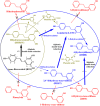Perspective on the Coevolutionary Role of Host and Gut Microbiota in Polyphenol Health Effects: Metabotypes and Precision Health
- PMID: 39538982
- PMCID: PMC11605795
- DOI: 10.1002/mnfr.202400526
Perspective on the Coevolutionary Role of Host and Gut Microbiota in Polyphenol Health Effects: Metabotypes and Precision Health
Abstract
"Personalized nutrition" aims to establish nutritional strategies to improve health outcomes for non-responders. However, it is utopian since most people share similar nutritional requirements. "Precision health," encompassing lifestyles, may be more fitting. Dietary (poly)phenols are "healthy" but non-nutritional molecules (thus, we can live without them). The gut microbiota influences (poly)phenol effects, producing metabolites with different activity than their precursors. Furthermore, producing distinctive metabolites, like urolithins, lunularin, and equol, leads to the term "polyphenol-related gut microbiota metabotypes," grouping individuals based on a genuine microbial metabolism of ellagic acid, resveratrol, and isoflavones, respectively. Additionally, (poly)phenols exert prebiotic-like effects through their antimicrobial activities, typically reducing microbial diversity and modulating microbiota functionality by impacting its composition and transcriptomics. Since the gut microbiota perceives (poly)phenols as a threat, (poly)phenol effects are mostly a consequence of microbiota adaptation through differential (poly)phenol metabolism (e.g., distinctive reductions, dehydroxylations, etc.). This viewpoint is less prosaic than considering (poly)phenols as essential nutritional players in human health, yet underscores their health significance in a coevolutionary partnership with the gut microbiota. In the perspective on the gut microbiota and (poly)phenols interplay, microbiota metabotypes could arbiter health effects. An innovative aspect is also emphasized: modulating the interacting microbial networks without altering the composition.
Keywords: gut microbiota; metabolite; metabotype; personalized nutrition; polyphenol.
© 2024 The Author(s). Molecular Nutrition & Food Research published by Wiley‐VCH GmbH.
Conflict of interest statement
The authors declare no conflict of interest.
Figures



Similar articles
-
Unveiling metabotype clustering in resveratrol, daidzein, and ellagic acid metabolism: Prevalence, associated gut microbiomes, and their distinctive microbial networks.Food Res Int. 2023 Nov;173(Pt 2):113470. doi: 10.1016/j.foodres.2023.113470. Epub 2023 Sep 11. Food Res Int. 2023. PMID: 37803793
-
(Poly)phenol-related gut metabotypes and human health: an update.Food Funct. 2024 Mar 18;15(6):2814-2835. doi: 10.1039/d3fo04338j. Food Funct. 2024. PMID: 38414364 Review.
-
Where to Look into the Puzzle of Polyphenols and Health? The Postbiotics and Gut Microbiota Associated with Human Metabotypes.Mol Nutr Food Res. 2020 May;64(9):e1900952. doi: 10.1002/mnfr.201900952. Epub 2020 Apr 9. Mol Nutr Food Res. 2020. PMID: 32196920 Review.
-
Main drivers of (poly)phenol effects on human health: metabolite production and/or gut microbiota-associated metabotypes?Food Funct. 2021 Nov 1;12(21):10324-10355. doi: 10.1039/d1fo02033a. Food Funct. 2021. PMID: 34558584 Review.
-
(Poly)phenol-gut microbiota interactions and their impact on human health.Curr Opin Clin Nutr Metab Care. 2025 Jul 1;28(4):316-322. doi: 10.1097/MCO.0000000000001132. Epub 2025 Apr 28. Curr Opin Clin Nutr Metab Care. 2025. PMID: 40293967 Free PMC article. Review.
Cited by
-
Oral Delivery of Ellagic Acid Encapsulated in Milk Exosomes: Sex-Based Differences in Bioavailability, Urolithin Production, and Gut Microbiota Modulation.Mol Nutr Food Res. 2025 Aug;69(15):e70104. doi: 10.1002/mnfr.70104. Epub 2025 May 12. Mol Nutr Food Res. 2025. PMID: 40351018 Free PMC article.
-
Angiogenesis as a Therapeutic Target of (Poly)phenols: Tackling Cancer and Vascular-Related Complications.Mol Nutr Food Res. 2025 Aug;69(15):e70110. doi: 10.1002/mnfr.70110. Epub 2025 May 15. Mol Nutr Food Res. 2025. PMID: 40370203 Free PMC article. Review.
References
-
- Davies N. T., Proc. Nutr. Soc. 1979, 38, 121. - PubMed
-
- Sugimura T., Nagao M., Weisburger J. H., CRC Crit. Rev. Toxicol. 1979, 6, 189. - PubMed
-
- Bondi A., Alumot E., Prog. Food Nutr. Sci. 1987, 11, 115. - PubMed
-
- Williamson G., Kay C. D., Crozier A., Compr. Rev. Food Sci. Food Saf. 2018, 17, 1054. - PubMed
-
- Hertog M. G. L., Feskens E. J. M., Kromhout D., Hertog M. G. L., Hollman P. C. H., Hertog M. G. L., Katan M. B., Lancet 1993, 342, 1007. - PubMed
Publication types
MeSH terms
Substances
Grants and funding
- Project/Ministry of Science, Innovation, and Universities (MICIU/AEI/10.13039/501100011033) and European Regional Development Fund
- PID2022-136419OB-100/Ministry of Science, Innovation, and Universities (MICIU/AEI/10.13039/501100011033) and European Regional Development Fund
- AGROALNEXTprogram(PRTR-C17.I1)/MICIU, European Union NextGenerationEU (PRTR-C17.I1) and Fundación Séneca
LinkOut - more resources
Full Text Sources

